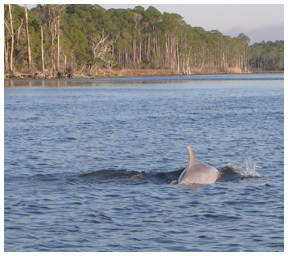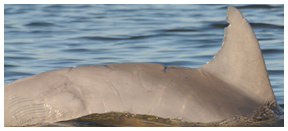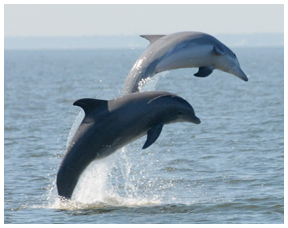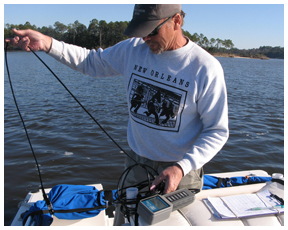
Research documents life patterns and health of bottlenose dolphin
Steve Shippee knows about dolphins. Studying the mammal’s behavior since he was 17, Shippee, a marine biologist, is currently the marine mammal research and stranding team coordinator for Emerald Coast Wildlife Refuge, and currently in the University of Central Florida PhD program in Conservation Biology. Shippee is doing his dissertation on dolphin habitat use and feeding ecology in two connected estuaries, Pensacola Bay and Choctawhatchee Bay.
Shippee has been doing research in the area since 2006. As a result of funding provided through the Florida Institute of Oceanography this summer, he has been working with Dr. Graham Worthy at UCF, the Sarasota Dolphin Research Program at Mote Marine Lab, and the Florida Fish and Wildlife Research Institute to study the potential impacts of the Deep Water Horizon oil spill on bottlenose dolphins in the two connected estuaries.

The study is to assess population size and genetic discreteness of oil spill impacted bottlenose dolphin communities in the bays; determine their feeding habits; and examine the relationship between feeding habits and trophic interactions as a diagnostic tool in assessing the potential impacts of oil/dispersants throughout the region.

As apex predators, dolphins serve as a key sentinel species for monitoring ocean and human health. The assessment of the current status of dolphins will determine the immediate impact of oil and residual contaminants on their distribution, habitat use, and feeding habits, which provides valuable insight into the impact of oil on lower parts of the marine food chain. Ultimately, these baseline data will be critical in the long-term assessment of our estuary’s overall health.
By taking high-resolution photos of the dolphin, Shippee identifies the individuals. The dolphins’ dorsal fin is used as a unique identifying marker. Scars occur on a dolphin from a variety of sources such as other dolphin bites, shark bites, line entanglements, human interactions, or natural occurring marks such as barnacle scars. Shippee can track the travel patterns of the dolphin by comparing photos over time.

Shippee conducts transect surveys of the bay to evaluate the dolphin population size. By documenting each section, he has estimated there are between 250 – 300 regularly living in the Choctawhatchee – Pensacola Bay estuaries. There are also dolphins that come and go seasonally that likely are infrequent visitors.
Dolphins are more mobile than Shippee had previously observed. He has spotted numerous dolphins that are routinely seen at Destin Pass as far west as the middle of Pensacola Bay. Some move in and out of the Gulf of Mexico, and some stay within the estuaries and travel back and forth through Santa Rosa Sound. He wonders if some also move between St. Andrews Bay and Choctawhatchee Bay through the Intracoastal Waterway barge canal.
A variety of additional information is gathered in Shippee’s study, such as habitat quality measurements of salinity levels and clarity of the water. In addition to conducting this work through the University of Central Florida, Shippee also participates in water quality monitoring work with the Choctawhatchee Basin Alliance at Northwest Florida State College, and red tide monitoring with Florida FWC.
To learn about the spill impacts on our local dolphins, members of the Mote Marine Lab research team assist with dart biopsy sampling from select dolphins. The marine mammal response team at Emerald Coast Wildlife Refuge also provides tissue samples collected from beached animals found in our region as a part of this study. The Florida Fish and Wildlife Research Institute is collecting specific fish that are known to be normal dolphin prey species from the two bays. These samples are all being analyzed for toxicological and enzyme markers to better understand oil exposure both from direct contact as well as through their food chain.
“Dolphins are a prime indicator of what’s happening at the top of the food chain. By studying their movements, feeding, and survival over time we learn a great deal about our entire marine ecosytem,” Shippee said.
Ultimately, this work will provide a window into the lives of our local dolphin communities, and help us better understand the impacts of environmental disasters on their complex interwoven ecosystem. Although we may never be certain that there was any long-lasting damage from the recent DWH spill, we will certainly be better prepared to respond to future incidents by knowing which components of our estuaries are the most vital to protect.
The project will continue through July 2011.
The project is funded by grant number 4710-1101-00-D from the Florida Institute of Oceanography.
Information courtesy Dolphin Biology Research Institute and Sarasota Dolphin Research Program at Mote Marine Lab. Photos were taken under the NOAA Fisheries Service Scientific Research Permit No. 522-1785.
Steve Shippee currently lives in Mary Esther, and grew up in the Fort Walton Beach area. He graduated with a degree in Marine Biology from the University of West Florida in 1983 and went on to work for the US Navy Marine Mammal Program in Hawaii and San Diego for 20 years. He returned to his Northwest Florida roots in 2005 to put his efforts into advancing our knowledge of, and ability to protect the unique marine environmental resources that surround this beautiful paradise.

1 Comment
Comments are closed.